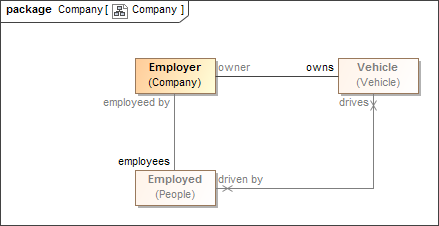The concept modeling profile of UML interprets the owner of a property as a context in which that property must conform to certain constraints. These constraints can include multiplicity (which includes a minimum cardinality and a maximum cardinality), a type for the property, existential quantification, and universal quantification, which is the default. When an instance is a member of an owning class, all of that class’ constraints must be met.
UML allows the cardinality of a property to be left unspecified. Unlike UML, which interprets unspecified cardinalities as a minimum of one and a maximum of one, the concept modeling profile interprets unspecified cardinalities as being zero to many (“0..*”).
An OWL ontology may contain properties in namespaces that are different from their domains. If you import an OWL ontology that has properties with foreign domains defined in such manner, you will see the association ends with cross (x) marks. In the Concept Modeler, these non-navigable association ends mean that the properties belong to foreign domains and therefore, they are owned by the association. The following diagram shows the examples of non-navigable association ends.
Properties owned by an association.
In the diagram, the Employer, Vehicle, and Employed classes belong to three different namespaces, and the association belongs to the same namespace as that of the Employer.
Note
It is recommended that duplicate property names in a concept modeling diagram be avoided because they will result in conflicting definition of domains and ranges when exported to OWL.
Related pages
